A brief history of Datchet's development
By Janet Kennish
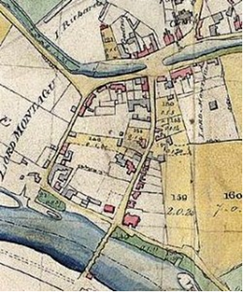
Early Settlement
There is archaeological evidence of settlements near the river from Neolithic to Roman times. The name 'Datchet' is of Celtic (pre-Roman) origin in an area where Celtic place-names are unusual. It seems to be the same place-name as the modern Decize on the Loire in France, once the chief town of the Dacetia tribe in Gaul. In common with most English villages, Datchet was recorded in the 1086 Domesday survey. Ditton Park has been closely associated with Datchet, as was Riding Court which lies between Datchet and Ditton.
The earliest settlement of the present village was centred around the church which is on an 'island' of high ground in otherwise low lying land and was probably a pre-Christian fortified site. Opposite, on the south side of the Green, is the Manor House range of buildings dating from the 1600s. The oldest buildings are the Royal Stag, Church Cottage and Astracot (in Horton Road), all from about 1500.
Map shows village centre, early 1800s, before the stream was culverted, and with Datchet Bridge over the Thames.
At that time the characteristic Village Greens did not exist and a stream ran through the centre of the village widening to a pool in front of the Manor House; this was culverted in the 1840s to create the dry land of the present Greens.
There is archaeological evidence of settlements near the river from Neolithic to Roman times. The name 'Datchet' is of Celtic (pre-Roman) origin in an area where Celtic place-names are unusual. It seems to be the same place-name as the modern Decize on the Loire in France, once the chief town of the Dacetia tribe in Gaul. In common with most English villages, Datchet was recorded in the 1086 Domesday survey. Ditton Park has been closely associated with Datchet, as was Riding Court which lies between Datchet and Ditton.
The earliest settlement of the present village was centred around the church which is on an 'island' of high ground in otherwise low lying land and was probably a pre-Christian fortified site. Opposite, on the south side of the Green, is the Manor House range of buildings dating from the 1600s. The oldest buildings are the Royal Stag, Church Cottage and Astracot (in Horton Road), all from about 1500.
Map shows village centre, early 1800s, before the stream was culverted, and with Datchet Bridge over the Thames.
At that time the characteristic Village Greens did not exist and a stream ran through the centre of the village widening to a pool in front of the Manor House; this was culverted in the 1840s to create the dry land of the present Greens.
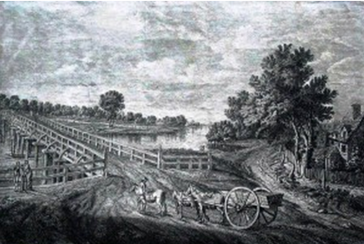
Ferry and bridge, Shakespeare and Royalty
The development of the village depended on its situation on the bank of the Thames opposite Windsor Castle. A ferry crossing to the Castle was provided by the Crown as a rapid route through the village to Colnbrook on the main road to London. This ferry existed from medieval times until 1706 when Queen Anne replaced it with a bridge (see image) for free public use, the land on the Windsor side of the river then being publicly accessible. The future Queen Mary was sometimes lodged at Ditton Park as a small child, conveyed across the Thames by Datchet ferry from Windsor Castle.
Shakespeare certainly knew Datchet, which is referred to in The Merry Wives of Windsor, but Datchet Mead, where Falstaff was dumped into a ditch by the Thames, is actually on the Windsor bank of the river. One local story concerns Charles II who is said to have kept his mistress Nell Gwynn at the Old Bridge House, but unfortunately there is no evidence for this at all. Charles II did go fishing further up river at Black Potts, and also attended horse racing on Datchet Mead, on the castle side of the river.
The development of the village depended on its situation on the bank of the Thames opposite Windsor Castle. A ferry crossing to the Castle was provided by the Crown as a rapid route through the village to Colnbrook on the main road to London. This ferry existed from medieval times until 1706 when Queen Anne replaced it with a bridge (see image) for free public use, the land on the Windsor side of the river then being publicly accessible. The future Queen Mary was sometimes lodged at Ditton Park as a small child, conveyed across the Thames by Datchet ferry from Windsor Castle.
Shakespeare certainly knew Datchet, which is referred to in The Merry Wives of Windsor, but Datchet Mead, where Falstaff was dumped into a ditch by the Thames, is actually on the Windsor bank of the river. One local story concerns Charles II who is said to have kept his mistress Nell Gwynn at the Old Bridge House, but unfortunately there is no evidence for this at all. Charles II did go fishing further up river at Black Potts, and also attended horse racing on Datchet Mead, on the castle side of the river.
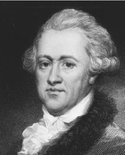
The Eighteenth Century
Throughout Tudor and Stuart times Datchet was attractive to royal courtiers, civil servants and London merchants, who occupied the Riding Court and Southlea estates as well as houses in the village centre. It was within the crucial distance of one day's ride from London as was Windsor Castle itself. From 1742 the Montagu and Buccleuch families owned both Ditton Park and Datchet Manor, living at Ditton and renting out village's Manor House range of dwellings. Economically, Datchet depended on agriculture and its two important Thames fisheries, which were recorded in the Domesday survey, and there is no evidence of any other industry. Much of the land remained as open fields from medieval times right up to enclosure in 1810.
The old main route along Horton Road towards Colnbrook and London was changed in the 1760s when the Colnbrook Turnpike Trust widened the narrow lane leading past the parish church to become our London Road. It provided a more direct access to the Bath Road (now the A4) and has now become a busy access to the M4.
From 1782 to 1785 the great astronomer Sir William Herschel (pictured) and his sister Caroline lived here, but the part of the house they occupied in Horton Road (The Lawn) no longer exists. Herschel, as King’s Astronomer to George III, demonstrated his telescopes to the King and his family at Windsor Castle. William had recently discovered the planet Uranus, and while in Datchet he and Caroline were mapping thousands of nebulae in the night sky.
Throughout Tudor and Stuart times Datchet was attractive to royal courtiers, civil servants and London merchants, who occupied the Riding Court and Southlea estates as well as houses in the village centre. It was within the crucial distance of one day's ride from London as was Windsor Castle itself. From 1742 the Montagu and Buccleuch families owned both Ditton Park and Datchet Manor, living at Ditton and renting out village's Manor House range of dwellings. Economically, Datchet depended on agriculture and its two important Thames fisheries, which were recorded in the Domesday survey, and there is no evidence of any other industry. Much of the land remained as open fields from medieval times right up to enclosure in 1810.
The old main route along Horton Road towards Colnbrook and London was changed in the 1760s when the Colnbrook Turnpike Trust widened the narrow lane leading past the parish church to become our London Road. It provided a more direct access to the Bath Road (now the A4) and has now become a busy access to the M4.
From 1782 to 1785 the great astronomer Sir William Herschel (pictured) and his sister Caroline lived here, but the part of the house they occupied in Horton Road (The Lawn) no longer exists. Herschel, as King’s Astronomer to George III, demonstrated his telescopes to the King and his family at Windsor Castle. William had recently discovered the planet Uranus, and while in Datchet he and Caroline were mapping thousands of nebulae in the night sky.
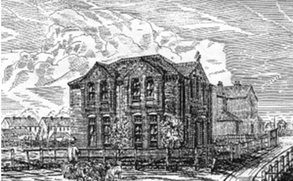
Victorian Development
In the early 1800s the village's reputation was so low that it was known as 'Black Datchet'. Development and improvement began around 1850 when the railway was built from Richmond to Windsor. A condition of the line being allowed through Crown land at the north of Datchet parish was that Datchet's Thames bridge should be removed and replaced by the new Albert and Victoria bridges above and below the village to take new roads to Windsor and to Old Windsor. The arrival of the railway and easy access to London led to dramatic expansion of the population, but few new houses were built before the mid-1870s when agricultural land began to be sold for housing development.
In the next few decades the philanthropic energies of the Parish Church and wealthy families brought many improvements and developments in people's lives: in 1843 the Rev. Isaac Gosset founded the village school; from 1857 to 1864 the church itself was almost entirely rebuilt; and from 1881 the Working Men's Club (see image, now Datchet Library) became a focus for village activities.
Datchet's characteristic Victorian 'mock Tudor' architectural style was introduced when the Manor House was restored and re-fronted in about 1870. Datchet earned a fashionable reputation for riverside pleasure trips, regattas and parties, with its station bringing crowds at weekends. This not only fuelled the demand for new houses, but brought new jobs of all kinds for the working classes so that housing development for them also boomed.
To commemorate Queen Victoria's golden jubilee in 1887 the great oak tree was planted in the middle of the village, to be joined by the jubilee cross for her 60th jubilee in 1897. In the 1890s there were two great floods, the first for which we have a photographic record. In 1895 the Hon Evelyn Ellis imported the first motor car into England from the continent, flouting the Red Flag Act in order to encourage the development of the British motor industry. Another pioneer with local connections was Tommy Sopwith, who landed his plane on the golf course in 1911 to the amazement of the population.
In the early 1800s the village's reputation was so low that it was known as 'Black Datchet'. Development and improvement began around 1850 when the railway was built from Richmond to Windsor. A condition of the line being allowed through Crown land at the north of Datchet parish was that Datchet's Thames bridge should be removed and replaced by the new Albert and Victoria bridges above and below the village to take new roads to Windsor and to Old Windsor. The arrival of the railway and easy access to London led to dramatic expansion of the population, but few new houses were built before the mid-1870s when agricultural land began to be sold for housing development.
In the next few decades the philanthropic energies of the Parish Church and wealthy families brought many improvements and developments in people's lives: in 1843 the Rev. Isaac Gosset founded the village school; from 1857 to 1864 the church itself was almost entirely rebuilt; and from 1881 the Working Men's Club (see image, now Datchet Library) became a focus for village activities.
Datchet's characteristic Victorian 'mock Tudor' architectural style was introduced when the Manor House was restored and re-fronted in about 1870. Datchet earned a fashionable reputation for riverside pleasure trips, regattas and parties, with its station bringing crowds at weekends. This not only fuelled the demand for new houses, but brought new jobs of all kinds for the working classes so that housing development for them also boomed.
To commemorate Queen Victoria's golden jubilee in 1887 the great oak tree was planted in the middle of the village, to be joined by the jubilee cross for her 60th jubilee in 1897. In the 1890s there were two great floods, the first for which we have a photographic record. In 1895 the Hon Evelyn Ellis imported the first motor car into England from the continent, flouting the Red Flag Act in order to encourage the development of the British motor industry. Another pioneer with local connections was Tommy Sopwith, who landed his plane on the golf course in 1911 to the amazement of the population.
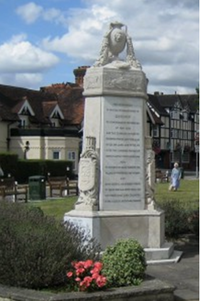
The Twentieth Century
The two world wars affected Datchet through great loss of its young men, as they did every village in the country. The war memorial, erected in 1920 is a particularly fine one.
In 1917 the Admiralty Compass Observatory compulsorily purchased Ditton Park House, and during WWII vital secret work on the development of radar took place there. Post-war, two major projects altered the landscape drastically: the arrival of the M4 and the building of the Queen Mother Reservoir. Since then, as in so many other communities, housing development and the burden of traffic have suburbanised the village, although it still manages to retain its special character. And it is thanks to the prosperity of the computer-based industry and Datchet's excellent travel connections that both Ditton Park House and Riding Court Farm have been restored and preserved for the future.
A Note on Spelling
Datchet's name has not changed over many centuries even though a great many variant spellings exist, including Daceta (in Latin), Datchette, Dochet, Detchet and Dachet. Spelling generally was not standardised until quite recently, so that both family and place names were simply written as the individual scribes heard them pronounced. There is no thread of development over time in the spellings and each variant is random.
Janet Kennish is chair of Datchet Village Society. To read more about Datchet's History, please visit Janet's website: www.datchethistory.org.uk
© Janet Kennish 2017.
The two world wars affected Datchet through great loss of its young men, as they did every village in the country. The war memorial, erected in 1920 is a particularly fine one.
In 1917 the Admiralty Compass Observatory compulsorily purchased Ditton Park House, and during WWII vital secret work on the development of radar took place there. Post-war, two major projects altered the landscape drastically: the arrival of the M4 and the building of the Queen Mother Reservoir. Since then, as in so many other communities, housing development and the burden of traffic have suburbanised the village, although it still manages to retain its special character. And it is thanks to the prosperity of the computer-based industry and Datchet's excellent travel connections that both Ditton Park House and Riding Court Farm have been restored and preserved for the future.
A Note on Spelling
Datchet's name has not changed over many centuries even though a great many variant spellings exist, including Daceta (in Latin), Datchette, Dochet, Detchet and Dachet. Spelling generally was not standardised until quite recently, so that both family and place names were simply written as the individual scribes heard them pronounced. There is no thread of development over time in the spellings and each variant is random.
Janet Kennish is chair of Datchet Village Society. To read more about Datchet's History, please visit Janet's website: www.datchethistory.org.uk
© Janet Kennish 2017.
